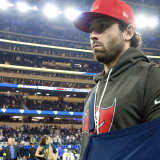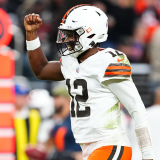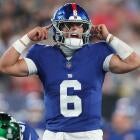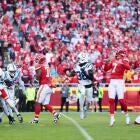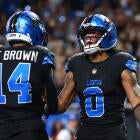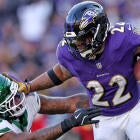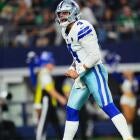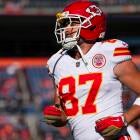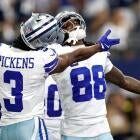
Giants offense looked different with Jaxson Dart replacing Russell Wilson: How rookie QB handled first start
The future is now for the Giants, who unveiled their first-rounder on Sunday

A new era began for the New York Giants on Sunday, with rookie quarterback Jaxson Dart making his first start under center.
The Giants came away with a surprising 21-18 win over the Los Angeles Chargers, and that's important, but perhaps more important in the grand scheme of the franchise is how Dart played, and how the Giants offense looked different with him under center than it did with his predecessor, Russell Wilson. And there were some major difference that stood out right away.
The first and most obvious thing was the quarterback run game. Dart had 10 rush attempts for 54 yards and a touchdown. You could see right from the first possession of the afternoon how the Giants wanted to incorporate his athleticism into the run game.
According to TruMedia, seven of Dart's 10 rush attempts were designed and three of them were scrambles. (Wilson, by comparison, had six designed rush attempts in three weeks.) On those designed runs, Dart gained 31 yards, and he scored from 15 yards out on a quarterback draw, as you can see above. The Giants opened rushing lanes for him through the use of motion and fakes, and they generally put him into position to succeed on those plays.
New York also built counters off of Dart's involvement in the run game. The shovel-pass touchdown to Theo Johnson came off very similar-looking action to Dart's first run of the game, where he faked rolling to his right and then came back to the middle for a run. On the touchdown, he made the same fake to the right, then flipped the ball forward rather than running up the middle.
The second major difference was in the operation of the passing game, and specifically how often the Giants involved short and quick throws as opposed to the type of longer-developing, deeper throws that Wilson favored.
According to TruMedia, 65% of Dart's throws came within 2.5 seconds of the snap. By contrast, Wilson released only 43.2% of his throws in that quick-game window. Befitting that style of play, the Giants also had Dart attack the shorter areas of the field more often than did Wilson. His average depth of throw was only 6.3 yards, compared with Wilson's 9.3 yards.
Just like they did during the preseason, the Giants aided Dart with a significant helping of easy-button throws: 25% of his passes (including the touchdown) were targeted to receivers behind the line of scrimmage, per TruMedia, while another 55% were thrown to receivers within 10 yards of the snap. Just four of his 20 pass attempts traveled more than 10 yards in the air. Wilson, meanwhile, had 18% of his throws behind the line, another 49.5% of within 10 yards and 32.4% deeper than 10 yards downfield. That's a pretty significant divergence between the two quarterbacks.
Because of the use of quick screens, bubble screens and play action, only 62% of Dart's dropbacks were considered "true" dropbacks by TruMedia, a much lower rate than Wilson's 73% mark. That's not to take away from what Dart did here -- it's good that the Giants gave him some help. That's what you're supposed to do with a rookie quarterback. (Go ask Cam Ward how difficult it is when your team doesn't give you help with motion and fakes and things like that and instead asks you to make big-time throws over and over in order to move the ball downfield. It can look pretty ugly, especially when your receivers continually drop passes.)
The few times the Giants tasked Dart with making in-rhythm throws down the field, they fell incomplete, and one of those wasn't particularly close to being completed. Dart threw both passes out of bounds, but one of them did at least give Darius Slayton a chance to come down with the ball over the top.
The Giants did draw a pass interference penalty on one deeper pass that didn't count, and Dart also threw deep down the field for Malik Nabers on a play where there was defensive offside, but that play unfortunately ended Nabers' season when he tore his ACL while trying to plant and jump for the (probably slightly under-thrown) ball in the air.
When asked to make short throws in the structure of the offense, Dart did pretty well a couple of times to get the ball out quickly and find his man in the underneath zones of the Chargers' two-deep coverages. He also missed a couple of those throws pretty badly, though, overthrowing Johnson over the middle and missing low on a quick out to Wan'Dale Robinson.
Dart's best work might have come outside the structure of the offense, which is perhaps no surprise given his athleticism. There were several occasions where he had to step up and through the pocket in the face of pressure bearing down, and he made a few really nice plays on those occasions.
He had a couple of completions over the middle when doing that and a nice scramble, and he nearly threw a game-sealing touchdown pass to Robinson in the back of the end zone, only for the pass to be broken up as Robinson tried to come down with it. That last pass could have been better, and he probably should have lasered it in there instead of floating the ball up in the air. but he did a good job to escape from pressure and even get a pass off to begin with.
On the opposite side of the ledger, there were several occasions where Dart flat out held the ball for too long and put himself in harm's way because he did. He took five sacks on his 28 dropbacks, which is an astronomical 17.8% sack rate. On three of those sacks, Dart had a chance to do something else with the ball before (whether take off and run or throw it away) Before running himself into the Chargers' pass rush instead. (The other two sacks came pretty quickly and there wasn't much he could have done about it.)
Dart also took a big hit on another run down the field, and he just generally took too many hits, period. He has to learn to be less reckless with his body, because you just can't get hit this often and make it through an entire season. He took 15 total hits, per Tru Media, which is just a ridiculous number for a player with only 28 dropbacks.
All in all, it was a solid, if somewhat unspectacular debut for Dart, largely because the Giants put him in position to succeed but also didn't ask him to overextend himself. His athleticism shined through, as did his quick decision-making on occasion, but so did some inaccuracy issues and a tendency to hold onto the ball for too long when nothing materialized right away.
Looking forward to the rest of the season, the Giants will have to continue to scheme things up for Dart, because they're not going to have Nabers the rest of the way and Slayton, Robinson and Johnson isn't the most imposing receiving corps.
Brian Daboll showed an ability to take advantage of the strengths Dart brings to the table in this first game, but things could get more difficult if opponents start playing more aggressive defense and challenge the receivers to prove they can get open against man coverage, rather than sitting in the soft zones the Chargers did for most of the game.
If that comes to fruition, it will be up to Dart to use his athleticism to make things happen outside the structure of the offense, because some of the easy-button type of stuff the Giants dialed up in his debut might not be quite as readily available in future games. He also has to be sure to take care of his body in those situations, because taking as many hits as he did in this game is simply not sustainable.



